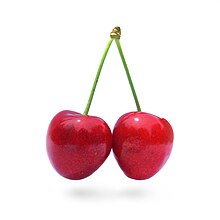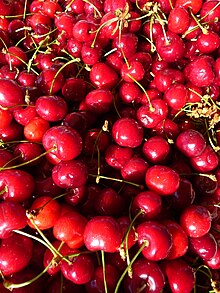Cherry
From Wikipedia, the free encyclopedia
 |
| Prunus avium, sweet cherry, also called wild cherry |
"Wild cherry" redirects here. For the species called "wild cherry" in the British Isles, see Prunus avium. For other uses, see Wild Cherry.
"Cherry tree" redirects here. For story about George Washington's honesty, see Parson Weems#The cherry-tree anecdote.
Botany
 |
| Prunus padus, bird cherry |
Most eating cherries are derived from either Prunus avium, the sweet cherry (also called the wild cherry), or from Prunus cerasus, the sour cherry.
History
Etymology and antiquity
The native range of the sweet cherry extends through most of Europe, western Asia and parts of northern Africa, and the fruit has been consumed throughout its range since prehistoric times. A cultivated cherry, as well as the apricot, is recorded as having been brought to Rome by Lucius Licinius Lucullus from northeastern Anatolia, also known as the Pontus region, historic Armenia, in 72 BC.A form of cherry was introduced into England at Teynham, near Sittingbourne in Kent by order of Henry VIII, who had tasted them in Flanders.
The English word cherry, French cerise and Spanish cereza all come from the classical Greek (κέρασος) through the Latin cerasum, thus the ancient Greek place name Cerasus, today a city in northern Turkey Giresun from which the cherry was first exported to Europe.
Wildlife value
Cherry trees also provide food for the caterpillars of several Lepidoptera.Cultivation
The cultivated forms are of the species sweet cherry (P. avium) to which most cherry cultivars belong, and the sour cherry (P. cerasus), which is used mainly for cooking. Both species originate in Europe and western Asia; they do not cross-pollinate. Some other species, although having edible fruit, are not grown extensively for consumption, except in northern regions where the two main species will not grow. Irrigation, spraying, labor, and their propensity to damage from rain and hail make cherries relatively expensive. Nonetheless, demand is high for the fruit. In commercial production, cherries are harvested by using a mechanized 'shaker'. Hand picking is also widely used to harvest the fruit to avoid damage to both fruit and trees.Growing season
Cherries have a very short growing season and can grow in most temperate latitudes. The peak season for cherries is in the summer. In Australia and New Zealand they are usually at their peak in late December, in southern Europe in June, in North America in June, in south British Columbia (Canada) in July to mid-August and in the UK in mid-July. In many parts of North America, they are among the first tree fruits to ripen, while in Australia and New Zealand cherries are widely associated with Christmas.'Kordia' is an early variety which ripens during the beginning of December, 'Lapins peak' ripens near the end of December, and 'Sweethearts' finish slightly later in the Southern Hemisphere.
Like most temperate-latitude trees, cherry seeds require exposure to cold to germinate (a mechanism the tree evolved to prevent germination during the autumn, which would then result in the seedling being killed by winter temperatures). The pits are planted in the autumn (after first being chilled) and seedlings emerge in the spring. A cherry tree will take three to four years to produce its first crop of fruit, and seven years to attain full maturity. Because of the cold-weather requirement, none of the Prunus family can grow in tropical climates.
Cultivars
The following cultivars have gained the Royal Horticultural Society's Award of Garden Merit:| Name | Size |
| Accolade | 64m² |
| Amanogawa | 32m² |
| Autumnalis (P. × subhirtella) | 64m² |
| Autumnalis Rosea (P. × subhirtella) | 32m² |
| Avium Grandiflora see Plena | |
| Colorata (P. padus) | 96m² |
| Grandiflora see Plena | |
| Kanzan | 100m²+ |
| Kiku-shidare-zakura | 16m²+ |
| Kursar | 64m² |
| Morello (P. cerasus) | 16m² |
| Okamé (P. × incam) | 96m² |
| Pandora | 96m² |
| Pendula Rosea | 16m² |
| Pendula Rubra | 16m² |
| Pink Perfection | 64m² |
| Plena (Grandiflora) | 100m²+ |
| Praecox (P. incisa) | 64m² |
| Prunus avium (sweet cherry) | 120m²+ |
| Prunus × cistena | 2.5m² |
| Prunus sargentii | 100m²+ |
| Prunus serrula (Tibetan cherry) | 100m²+ |
| Shirofugen | 64m² |
| Shirotai | 64m² |
| Shōgetsu | 64m² |
| Spire | 96m² |
| Stella | 16m² |
| Ukon | 64m²+ |
Commercial production
 |
| Worldwide cherry yield |
| Rank | Country | Production |
|---|---|---|
| 1 | 438,550 | |
| 2 | 303,376 | |
| 3 | 241,117 | |
| 4 | 112,775 | |
| 5 | 101,945 | |
| 6 | 92,520 | |
| 7 | 82,000 | |
| 8 | 81,842 | |
| 9 | 76,000 | |
| 10 | 72,800 | |
| 11 | 62,195 | |
| 12 | 61,088 | |
| 13 | 48,054 | |
| 14 | 44,200 | |
| 15 | 37,984 | |
| 16 | 37,035 | |
| 17 | 32,000 | |
| 18 | 30,063 | |
| 19 | 28,551 | |
| World | 2,196,000 | |
| Source: UN Food & Agriculture Organization | ||
Eurasia
North America
 |
| Cherries |
Australia
In Australia, cherries are grown in all the states except for the Northern Territory. The major producing regions are located in the temperate areas within New South Wales, Victoria, South Australia and Tasmania. Western Australia has limited production in the elevated parts in southwest of the state. Key production areas include Young, Orange and Bathurst in New South Wales, Wandin, the Goulburn and Murray valley areas in Victoria, the Adelaide Hills region in South Australia, and the Huon and Derwent Valleys in Tasmania.Key commercial varieties in order of seasonality include 'Empress', 'Merchant', 'Supreme', 'Ron's seedling', 'Chelan', 'Ulster', 'Van', 'Bing', 'Stella', 'Nordwunder', 'Lapins', 'Simone', 'Regina', 'Kordia' and 'Sweetheart'. New varieties are being introduced, including the late season 'Staccato' and early season 'Sequoia'. The Australian Cherry Breeding program is developing a series of new varieties which are under testing evaluation.
The New South Wales town of Young is called the "Cherry Capital of Australia" and hosts the National Cherry Festival.
Nutritional value
|
||||||||||||||||||||||||||||||||||||||||||||||||||||||||||||||||||||||
|
||||||||||||||||||||||||||||||||||||||||||||||||||||||||||||||||||||||
Compared to sweet cherries, raw sour cherries contain higher content per 100 g of vitamin C (12% DV) and vitamin A (8% DV).
Phytochemical research
Cherry anthocyanins, a class of phytochemical red pigments, were shown in preliminary research to possibly affect pain and inflammation mechanisms in rats. Anthocyanins may have other effects which remain under basic research for their potential mechanisms. For example, according to one study, genetically obese rats given a diet of tart cherry powder mixed into a high-fat diet did not gain weight or body fat like those on a similar diet without the powder, and their blood levels of inflammation indicators were lower.Other information
The wood of some cherry species is especially esteemed for the manufacture of fine furniture.[42]Species
The list below contains many Prunus species that bear the common name cherry, but they are not necessarily members of the subgenus Cerasus, or bear edible fruit. For a complete list of species, see Prunus. Some common names listed here have historically been used for more than one species, e.g. "rock cherry" is used as an alternative common name for both P. prostrata and P. mahaleb and "wild cherry" is used for several species.- Prunus apetala (Siebold & Zucc.) Franch. & Sav. - clove cherry
- Prunus avium (L.) L. - sweet cherry, wild cherry, mazzard or gean
- Prunus campanulata Maxim. - Taiwan cherry, Formosan cherry or bell-flowered cherry
- Prunus canescens Bois. - grey-leaf cherry
- Prunus caroliniana Aiton - Carolina laurel cherry or laurel cherry
- Prunus cerasoides D. Don. - wild Himalayan cherry
- Prunus cerasus L. - sour cherry
- Prunus cistena Koehne - purple-leaf sand cherry
- Prunus cornuta (Wall. ex Royle) Steud. - Himalayan bird cherry
- Prunus cuthbertii Small - Cuthbert cherry
- Prunus cyclamina Koehne - cyclamen cherry or Chinese flowering cherry
- Prunus dawyckensis Sealy - Dawyck cherry
- Prunus dielsiana C.K. Schneid. - tailed-leaf cherry
- Prunus emarginata (Douglas ex Hook.) Walp. - Oregon cherry or bitter cherry
- Prunus eminens Beck - German: mittlere Weichsel (semisour cherry)
- Prunus fruticosa Pall. - European dwarf cherry, dwarf cherry, Mongolian cherry or steppe cherry
- Prunus gondouinii (Poit. & Turpin) Rehder - duke cherry
- Prunus grayana Maxim. - Japanese bird cherry or Gray's bird cherry
- Prunus humilis Bunge - Chinese plum-cherry or humble bush cherry
- Prunus ilicifolia (Nutt. ex Hook. & Arn.) Walp. - hollyleaf cherry, evergreen cherry, holly-leaved cherry or islay
- Prunus incisa Thunb. - Fuji cherry
- Prunus jamasakura Siebold ex Koidz. - Japanese mountain cherry or Japanese hill cherry
- Prunus japonica Thunb. - Korean cherry
- Prunus laurocerasus L. - cherry laurel
- Prunus lyonii (Eastw.) Sarg. - Catalina Island cherry
- Prunus maackii Rupr. - Manchurian cherry or Amur chokecherry
- Prunus mahaleb L. - Saint Lucie cherry, rock cherry, perfumed cherry or mahaleb cherry
- Prunus maximowiczii Rupr. - Miyama cherry or Korean cherry
- Prunus mume (Siebold & Zucc.) - Chinese plum or Japanese apricot
- Prunus myrtifolia (L.) Urb. - West Indian cherry
- Prunus nepaulensis (Ser.) Steud. - Nepal bird cherry
- Prunus nipponica Matsum. - Takane cherry, peak cherry or Japanese alpine cherry
- Prunus occidentalis Sw. - western cherry laurel
- Prunus padus L. - bird cherry or European bird cherry
- Prunus pensylvanica L.f. - pin cherry, fire cherry, or wild red cherry
- Prunus pleuradenia Griseb. - Antilles cherry
- Prunus prostrata Labill. - mountain cherry, rock cherry, spreading cherry or prostrate cherry
- Prunus pseudocerasus Lindl. - Chinese sour cherry or false cherry
- Prunus pumila L. - sand cherry
- Prunus rufa Wall ex Hook.f. - Himalayan cherry
- Prunus salicifolia Kunth. - capulin, Singapore cherry or tropic cherry
- Prunus sargentii Rehder - Sargent's cherry
- Prunus serotina Ehrh. - black cherry, wild cherry
- Prunus serrula Franch. - paperbark cherry, birch bark cherry or Tibetan cherry
- Prunus serrulata Lindl. - Japanese cherry, hill cherry, Oriental cherry or East Asian cherry
- Prunus speciosa (Koidz.) Ingram - Oshima cherry
- Prunus ssiori Schmidt- Hokkaido bird cherry
- Prunus stipulacea Maxim.
- Prunus subhirtella Miq. - Higan cherry or spring cherry
- Prunus takesimensis Nakai - Takeshima flowering cherry
- Prunus tomentosa Thunb. - Nanking cherry, Manchu cherry, downy cherry, Shanghai cherry, Ando cherry, mountain cherry, Chinese dwarf cherry, Chinese bush cherry
- Prunus verecunda (Koidz.) Koehne - Korean mountain cherry
- Prunus virginiana L. - chokecherry
- Prunus x yedoensis Matsum. - Yoshino cherry or Tokyo cherry
Tidak ada komentar:
Posting Komentar